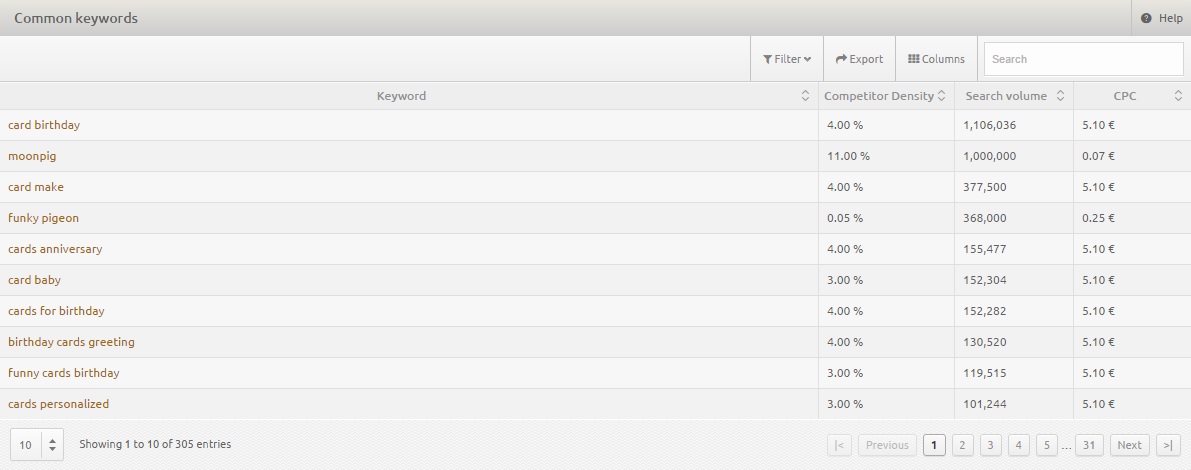Whether organic keywords, paid keywords or backlinks, domain comparison is an integral part of competitor analysis. However manually comparing tables and spreadsheets in Excel can be painstaking, time-consuming and down right boring, so the XOVI Suite offers a range of inbuilt features to make life easier – and more fun! Using the example of Moonpig and Funky Pigeon, this blog post explains how to compare rival domains quickly and easily in XOVI.
Keywords
Let’s say we want to compare and contrast the ranking keywords for these two behemoths of the greetings cards industry in order to see which domain ranks highest in Google for which keywords. We also want to identify keywords for which our competitor ranks higher but for which we don’t – yet! Start by heading over to the “Ranking Comparison” via the Keyword Tool in the main menu.

First, select the data on which you would like to base the comparison by choosing a date from the drop-down menu. This determines the weekly data set for which the keywords are compared. In this example, we’re using the www.moonpig.com. XOVI updates this data on a weekly basis and stores data sets as far back as 2009. In this example, we are using current XOVI data.
In the “Domains” field, enter the domains whose ranking data you wish to compare. The currently active project domain (Moonpig) is already there by default and we have added Funky Pigeon too. Feel free to add extra domains, however this is likely to complicate the data. First, we’re going to search for common keywords. Were we to enter several different domains, XOVI would attempt to identify keywords for which all the domains rank in the top 100, which is obviously more difficult. So we’ll still to one competitor domain for the time being.
Having entered the domains and selected the dataset, click on GO.
After a few seconds, XOVI presents a table of keywords:
The “Keywords” column contains all the keywords in the XOVI database for which Moonpig and Funky Pigeon both rank in the top 100 in Google.
The “Se.Vo” column contains the montly search volumes, in other words, how often these terms are searched for in Google per month. These are not XOVI’s own figures; they are are taken from Google themselves. The same applies to CPC – cost per click – which tells you how much you would have to pay in Google AdWords to achieve a similar ranking.
The last two columns contain the positions of each domain for each keyword. We can see for instance that Moonpig ranks at position 14 for the keyword “valentine’s” whereas Funky Pigeon ranks twice as far down at 28. On the other hand, Funky Pigeon ranks a lot higher than Moonpig for the keyword “gifts birthday” (14 vs 83). In this way we can analyse the strengths and weaknesses of a domain in comparison to a competitor.
Now it could be that there are keywords with which one domain ranks in the top 100 but the other doesn’t. If we were in charge of Moonpig’s SEO, we would need to know if this was the case for Funky Pigeon and ourselves, and therefore what keywords are out there for which we should be optimising but currently are not.
Using the filter options in XOVI’s domain comparison, we can see these keywords in just two clicks.

Use the switch to the right to deactivate data for our own domain, Moonpig, and click “apply filter”. XOVI then searches its database for all keywords for which Moonpig doesn’t rank but for which Funky Pigeon does, eliminating the need for the tiresome sorting and messing around in Excel.
The results look like this:

We can see in the penultimate column that keyword data for Moonpig has been excluded using the filter. These are therefore the keywords for which Moonpig does not rank in the top 100 search results. But Funky Pigeon does.
Let’s the keyword “get well” for example, for which Funky Pigeon ranks on page 1 (position 6) whereas Moonpig doesn’t feature in the top 100 at all! We can draw the conclusion that Funky Pigeon have created get well soon content for the page, and are offering cards for friends and relatives who are ill. With a search volume of over 700,000, perhaps it’s worth Moonpig implementing measures to optimise for this popular keyword and gain ground on the competition.
Backlinks
Whilst some recent studies have suggested that backlinks are becoming less and less important in Google’s search algorithm, it still remains the case in 2015 that backlinks are an important ranking factor. What has changed however is that the sheer quantity of links is no longer important, rather the quality. Indeed, XOVI has recently launched a brand new Link Disavow tool which analyses your link profile to enable you to remove, or disavow – harmful backlinks.
For the time being though in this article, similar to with the keywords, we’re going to focus on comparing the backlinks of two different domains. Which backlink sources have both domains already utilised and, most importantly, which domains are “exclusive” to either domain or the other?
Head to Links > Domain Comparison in the XOVI Suite. The currently “active” domain (in other words, our domain, Moonpig) will be analysed by default. Enter the competitor domain in the search field and click on “start analysis”.

Three tables are now shown: “Shared link sources”, “Exclusive starter domain backlinks” and “Exclusive comparison domain backlinks”.

In the first column, link sources are sorted by domain. When it comes to competitor backlink analysis, it doesn’t really matter what subpage URL a link comes from but rather from which overall domain. Click on the “plus” icon at the top right to see a more detailed breakdown of the exact link source URLs, as well as those of the competitor domain.
The other two tables are similarly structured.
The most important table for competitor backlink analysis is the third one. This table contains backlink sources which are exclusive to your competitor. In other words, domains from which the competitor receives valuable links, but from which you do not. Remember that this is a quantitative analysis; for more qualitative results it is worth expanding a particular domain by clicking on the “plus” button to take a closer look at the exact URLs and draw more meaningful conclusions for your own link building strategy.

To coincide with Dmexco2015 in Cologne, XOVI revealed a new, more powerful backlink tool. The new database contains substanially more links which are more current. Links are recrawled and updated more often so that link comparisons in the XOVI Suite are more powerful and more revealing than ever before.
Ad Keywords (SEA)
In addition to standard organic SEO, many webmasters also conduct paid Google AdWords campaigns. This makes particular sense for new projects and more highly competitive sectors. When setting up keywords for which to place adverts, Google makes its own suggestions in its AdWords tool. Nevertheless, it is always advisable to double-check these suggestions against the results of an independent competitor analysis in order to see which keywords your main competitors are actually placing adverts for. If the comparison reveals keywords for which the competition runs successful adverts but for which you do not, it could be worth adding these to your ad campaigns.
Head over to SEA > Domain Comparison in the XOVI Suite
Similar to the backlink comparison, type or copy the desired comparison domain into the box. In our example, we’re entering www.funkypigeon.com. We can also select the dataset we would like to base our analysis on – we don’t have to use the most up to date XOVI data, we can check on historical developments too. Finally, click on “Apply”.

Once again, three tables are shown. The first contains “Common Keywords” – in other words, keywords for which both domains place Google AdWords. Figures such as competitor density, search volume and CPC give the first indications. Since these are not live figures, it’s always worth double-checking them against Google’s own AdWords tool before applying them to your campaigns. For an initial overview however, they are more than adequate.
The next table contains keywords which could be taken into account by Moonpig – keywords for which Funky Pigeon already place ads but Moonpig do not. Important: the figures say little about the the quality of the backlinks, merely the quantity. Ads should never be placed for keywords based on quantity alone – but that is a matter for Moonpig to decide on an individual basis.
Conclusion
The keyword, link and SEA tools in the XOVI Suite provide numerous different opportunities for informative domain comparison in just a few clicks, eliminating the need for the time-consuming Excel work etc. On the contrary – carry out your filtering quickly and easily in XOVI before exporting.
More information on competitor analysis with XOVI is available in a handy “competitor analysis checklist” which is available to download as a PDF from www.xovi.com. Good luck!


